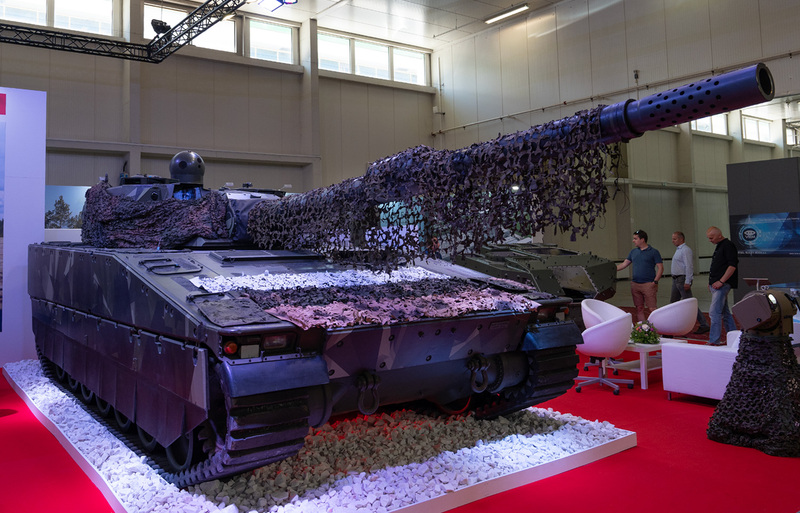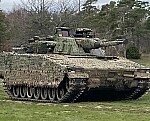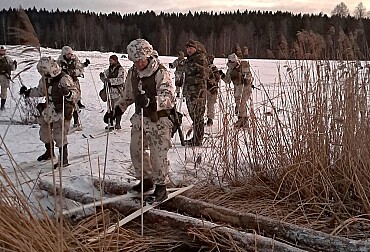BAE Systems offers CV90120 light tanks to Slovakia. Does it make sense to acquire them?
Dozens of companies involved in the defence industry presented themselves at this year's IDEB 2024 in Bratislava. One of them was also BAE Systems Hägglunds, which, together with its Slovak partners, presented the progress in cooperation with the Slovak defence industry on the CV90MkIV tracked IFV project for the Slovak army. BAE Systems Hägglunds was also exhibiting at IDEB the CV90120 "light tank", which Tarkan Turkcan, CV90 platform director, said could be attractive to Slovakia. The question is whether the introduction of the CV90120 would make sense for the Slovak Armed Forces.

The Ground Forces of the Slovak Republic will undergo significant modernisation in the coming years. The first Patria 8x8 AMVXP armoured personnel carrier has already been inducted into the armament, and CV90MkIV tracked infantry fighting vehicles with a 35-millimetre calibre gun will also be inducted in the near future. At the same time, the Ground Forces of the Slovak army received a total of 15 older Leopard 2A4 tanks from Germany as compensation for providing 30 BVP-1 infantry fighting vehicles to Ukraine.
The acquisition of new tanks is the last step towards the complete rearmament of the Slovak Ground Forces with modern Western equipment. Slovakia currently has a total of 30 T-72M1 tanks in its arsenal, and although they are in combat-ready condition, according to available data, all of them are beyond their operational life cycle. The Long-term Development Plan of the Ministry of Defence with a view to 2035 also responds to this situation. According to this strategic document, Slovakia has the ambition to make a decision on the acquisition of new, modern tanks by 2026.
Despite the fact that the purchase of new tanks for the Slovak Armed Forces has not yet been decided, some information has emerged about the direction Slovakia could take. For example, Slovak Defence Minister Robert Kaliňák has mentioned the possibility of acquiring Leopard 2A8 tanks several times in his recent statements, in which the Slovak defence minister sees potential for the Slovak defence industry in the form of a partial transfer of production to Slovakia. In the past, there was also a rumour about the possibility of acquiring South Korean-made K2 Black Panther tanks. This is probably one of the reasons why BAE Systems Hägglunds brought its CV90120 to Bratislava.
Are light tanks the solution?
At this year's IDEB, Tarkan Turkcan, director of the CV90 platform at BAE Systems Hägglunds, outlined the possibility of introducing these "light tanks" into the armament of the Slovak Republic. According to him, the CV90120 offers the ideal combination of the agility and manoeuvrability of an infantry fighting vehicle with the firepower of a tank, which in this case consists of a 120mm autoloading cannon. Other advantages of the CV90120 according to Turkcan are lower weight compared to traditional main battle tanks, lower fuel consumption, numerous identical spare parts with the CV90 infantry fighting vehicle and savings on crew training.
While the reasons given by BAE Systems Hägglunds representative are quite logical, we need to look at the light tank concept itself and whether these weapon systems can fully replace conventional tanks. The first thing to look at when comparing light tanks and main battle tanks is the use of these vehicles on the battlefield. Light tanks are derived from infantry fighting vehicle designs, making them lighter and more mobile in the field. On the other hand, precisely because they are based on the infantry fighting vehicle design, they cannot be considered as tanks. The primary role of infantry fighting vehicles on the battlefield is to transport troops, support infantry or destroy live forces and targets with lower levels of ballistic protection. The lower weight of these vehicles often stems from the fact that, in order to maintain a high level of mobility, they have weaker armour than main battle tanks and their armament consists of lower calibre guns.
Main battle tanks, on the other hand, are the key firepower of the army. Today, Western-made tanks are standardly armed with a 120mm cannon and their main task on the battlefield is to destroy any enemy armoured equipment. At the same time, main battle tanks have a higher level of ballistic and mine protection than infantry fighting vehicles, but this significantly increases their weight. Light tank manufacturers today also use 105- or 120-millimetre calibre guns for their light tanks in order to meet the firepower of traditional tanks, but the integration of such guns increases the weight of the vehicle itself. If light tanks were to fully replace main battle tanks, they would also have to be equipped with more advanced active protection systems and additional armour, which would again increase their weight. Just to illustrate, the weight of infantry fighting vehicles today, depending on configuration, ranges from 38 to 50 tonnes, while the weight of tanks ranges from 60 tonnes upwards. The important role of tanks on the battlefield is also demonstrated by the conflict in Ukraine, where Ukraine itself asked its Western allies to supply Western-made tanks to fight the Russian army. These tanks are in most aspects more technologically sophisticated than, for example, the Russian T-72 tanks.
So, are light tanks a suitable solution for the armed forces compared to main battle tanks? Although light tanks are a more economically viable solution than main battle tanks, it is not yet possible to talk about their ability to match traditional tanks. This fact is also recognized by Slovakia, as this Central European country plans to order 104 main battle tanks as the recent information suggest. Even the acquisition projects of European countries in the last months clearly declare that tanks are, and probably will continue to be, the main firepower of ground forces. On the other hand, light tanks offer an interesting concept, where certain combat groups could consist of just one platform with different types of main weapons. This possibility is being offered to Slovakia by the aforementioned BAE Systems Hägglunds. While Slovakia should not replace traditional tanks with light tanks, it can play with the idea of integrating more powerful cannons into CV90 vehicles in the future.










